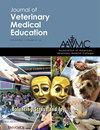Veterinary Student Evaluations of Teaching: Scores and Response Rate When Administered before or after Final Exams
IF 1.1
3区 农林科学
Q3 EDUCATION, SCIENTIFIC DISCIPLINES
引用次数: 0
Abstract
In higher education, instructors and administrators use student evaluations of teaching (SETs) as formative and summative assessments of instruction; thus, they need adequate response rates for optimal validity and reliability. Veterinary students are often requested to complete dozens of SETs each semester, and response rate is shown to decline as the number of SETs increases. Allowing students to complete SETs after final examinations has been suggested to help increase response; however, students’ knowledge of their final course grade has been previously shown to negatively influence SET scores. This case study explored how making SETs available to veterinary students after final exams affected quantitative item scores and response rate when compared to SETs administered during the final weeks of the semester, prior to final examinations. Participants ( n = 262) were randomly assigned to before finals or after finals groups, and 171 students completed 2,926 SETs. Students were more likely to complete evaluations before finals (vs. after), and first-year students completed more SETs than third-year students. Compared to the prior year, in which SETs were administered before finals, students in the study year completed 31% fewer SETs. Timing of SET delivery did not significantly affect SET item scores, but third-year students rated instructors higher than first-year students on five of 10 items. Students’ self-reported expected grade was positively correlated with all 10 SET items for both groups. In this study, timing of completion had no statistical effect on SET item score. However, when students completed SETs after final exams, response rates decreased.兽医专业学生对教学的评价:期末考试之前或之后进行的评分和回复率
在高等教育中,教师和管理人员使用学生教学评价(SET)作为教学的形成性和终结性评估;因此,他们需要足够的回复率来获得最佳的有效性和可靠性。兽医专业的学生每学期往往要完成几十份 SET,而且随着 SET 数量的增加,回复率也会下降。有人建议让学生在期末考试后完成 SET,以帮助提高回复率;然而,以前的研究表明,学生对其期末课程成绩的了解会对 SET 分数产生负面影响。本案例研究探讨了在期末考试后向兽医专业学生提供 SET 与在期末考试前的学期最后几周进行的 SET 相比,会如何影响定量项目得分和应答率。参与者(n = 262)被随机分配到期末考试前或期末考试后两组,共有 171 名学生完成了 2926 份 SET。学生更倾向于在期末考试之前(与之后)完成评估,一年级学生比三年级学生完成了更多的 SET。与前一年在期末考试前进行 SET 相比,本研究年完成 SET 的学生减少了 31%。提供 SET 的时间对 SET 项目得分没有显著影响,但在 10 个项目中,三年级学生对指导教师的评价有 5 个项目高于一年级学生。两组学生自我报告的预期成绩与所有 10 个 SET 项目均呈正相关。在本研究中,完成时间对 SET 项目得分没有统计学影响。然而,当学生在期末考试后完成 SET 时,回答率会下降。
本文章由计算机程序翻译,如有差异,请以英文原文为准。
求助全文
约1分钟内获得全文
求助全文
来源期刊
CiteScore
2.20
自引率
30.00%
发文量
113
审稿时长
>36 weeks
期刊介绍:
The Journal of Veterinary Medical Education (JVME) is the peer-reviewed scholarly journal of the Association of American Veterinary Medical Colleges (AAVMC). As an internationally distributed journal, JVME provides a forum for the exchange of ideas, research, and discoveries about veterinary medical education. This exchange benefits veterinary faculty, students, and the veterinary profession as a whole by preparing veterinarians to better perform their professional activities and to meet the needs of society.
The journal’s areas of focus include best practices and educational methods in veterinary education; recruitment, training, and mentoring of students at all levels of education, including undergraduate, graduate, veterinary technology, and continuing education; clinical instruction and assessment; institutional policy; and other challenges and issues faced by veterinary educators domestically and internationally. Veterinary faculty of all countries are encouraged to participate as contributors, reviewers, and institutional representatives.

 求助内容:
求助内容: 应助结果提醒方式:
应助结果提醒方式:


